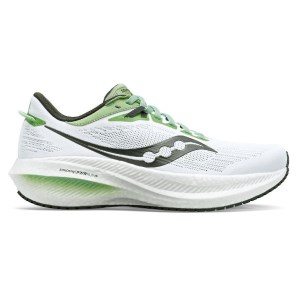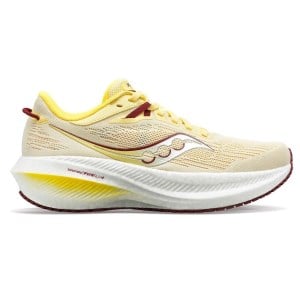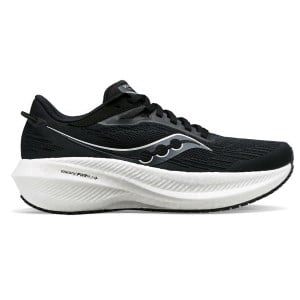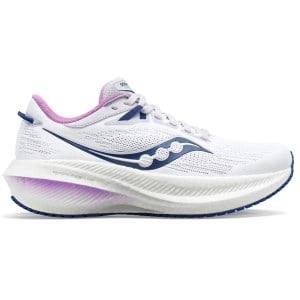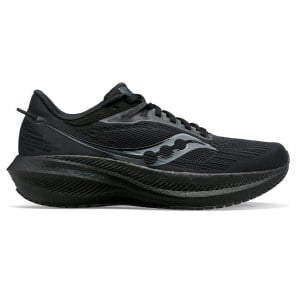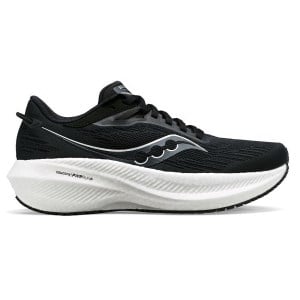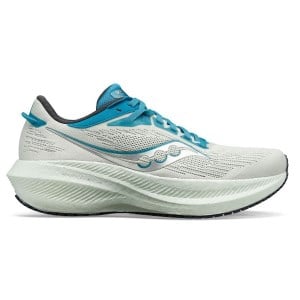Saucony Triumph 21 vs 20 Comparison Running Shoe Review
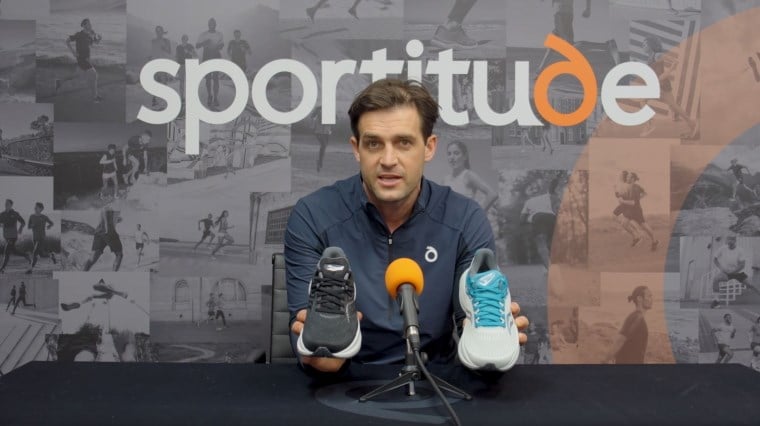
The main difference between the Saucony Triumph 21 running shoes and the Saucony Triumph 20 running shoes is that the Saucony Triumph 21 has had a 2mm boost to its stack height. Saucony have kept the ever-reliable PWRRUN+ technology in play while re-engineering the midsole to be thicker to increase its lifespan.
Saucony have rolled over the outsole of the previous model to this newest generation – gearing you up with an identical rubber compound underfoot for durability and trusted protection of the PWRRUN+ midsole.
In the upper, Saucony have traded the engineered mesh for a flat-knit construction, creating additional strength across the forefoot without compromise to breathability. The upper keeps your foot locked-in on the snappy midsole, for kilometre after kilometre of smooth and distraction-free running.
Offering a high-performance ride for your high mileage training, this neutral running shoe provides a balanced formula of cushioning and responsiveness your feet will love.
Check out the review with full transcript below.
Hey guys, Josh here from Sportitude Running. It's shoe review time and today we're going to be taking a deep dive look at the Saucony Triumph 21 and having a discussion about where it's come from with the Saucony Triumph 20.
Here at Sportitude Running we are expecting big things with the Saucony Triumph 21 because it was a very successful shoe last year through 2022 and the front half of 2023.
In today's review we're going to go through all the significant details of a running shoe and talk about the outsole, midsole and upper. We'll also talk to you about the changes that Saucony have made with the new version and discuss all the things that you need to know to potentially make this your next daily trainer.
What Foot Type Should Consider The Saucony Triumph 21 & Who Is This Running Shoe For?
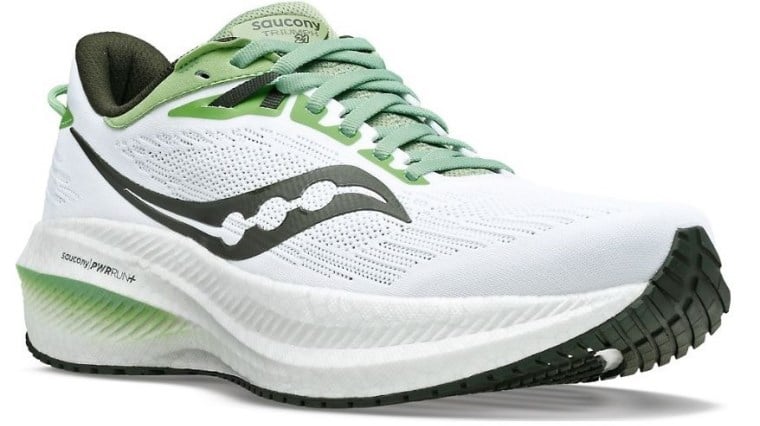
The Saucony Triumph 21 is a neutral shoe and it's a high mileage running shoe, so it's a workhorse. It's designed to spend plenty of hours out on the road and targets that foot type that doesn't need or have a reliance on medial support. It is specifically talking to that neutral to mildly supinated foot type.
However, I am a mild pronator and I really enjoy the Saucony Triumph, especially the Saucony Triumph 20 and I've enjoyed my few runs in the Saucony Triumph 21.
Outsole

Let's get stuck into today's comparison of the Saucony Triumph 21 and the Saucony Triumph 20. I want to look at the outsole first. The reason I want to do that is because the outsole is exactly the same.
That is a very good thing because the outsole was one of the best features of the Saucony Triumph 20. It's not often that an outsole can outperform or outlast the midsole in today's running shoe markets.
With that in mind, there's a lot of different technologies with midsoles, but we found that the outsole was so durable it protected the midsole very well last year in the Saucony Triumph 20.
The fact that they used the exact same compound of rubber, the same amount of flex grooves and the same positioning on the Saucony Triumph 21, means we are going to expect the same outcome with the performance of that outsole which is a great thing.
Upper
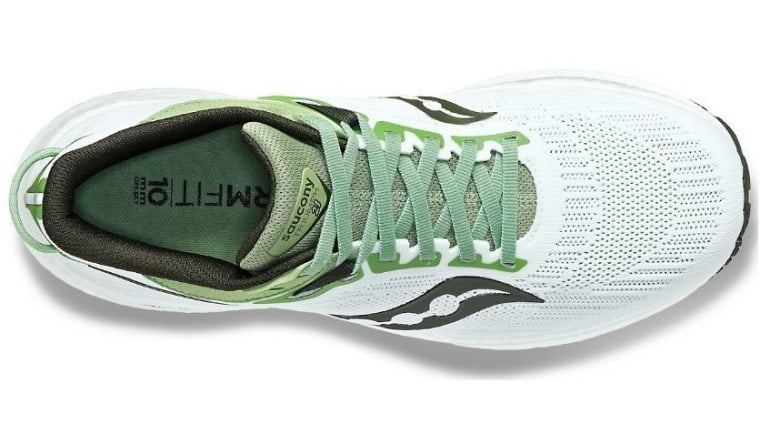
Coming to the upper, there’s pretty significant change from Saucony. We have gone from an engineered mesh to a flat-knit construction with regards to the Saucony Triumph 21.
Looking at the running shoe to the naked eye, there's not a whole heap of change to be completely honest and you wouldn't expect a lot. With brands changing subtle things in the outsole, midsole or upper, they really don't want to recreate the wheel too much.
I'm saying that tongue-in-check because a lot of brands sometimes put a bit too much effort in regards to what they change. However, Saucony know they've got a good product and they don't want to alter it too much.
The flat-knit construction has provided a little bit more strength across from your first metatarsal being your big toe, right through to your fifth metatarsal or your fifth toe. It's a good thing because that's where a lot of that upper gets a lot of force and stretch as you toe-off.
As you bend through to that forefoot, you really want that upper to be nice and stable, sound and strong, but still execute breathability which is what the Saucony Triumph 20 was really well known for.
Higher mileage neutral shoes breathe incredibly well and you're going to get the same outcome with the Saucony Triumph 21, just with a little bit more durability across that toe box.
One thing I found in terms of the overall fit is that the Saucony Triumph 20 offered a pretty relaxed fit. The Saucouny Triumph 21 that Saucony sent to me was be a little bit shallower through the forefoot.
I have a slightly voluminous forefoot and it's not going to be the case for every single runner, but I did jump up half a size in the Saucony Triumph 21. I went from a size US 9 in the Saucony Triumph 20 and I am now running in a US 9.5 in the Saucony Triumph 21.
However, there are a few team members at Sportitude Running that have stayed the same size from the Saucony Triumph 20 to the Saucony Triumph 21, mainly due to the fact they have a relatively shallow foot.
It's important to know that if you are looking to jump from a Saucony Triumph 20 to a Saucony Triumph 21. If you're lucky enough to live near a running shop or come into ours here at Sportitude Running at Hindmarsh in Adelaide, South Australia, you'll be able to try them on and make sure you get that size right.
It's an important part of getting the fit right and I'd certainly encourage you to go in and try on your Saucony Triumph 21.
Coming back to the tongue, it’s very similar to what we expected last year with about the same amount of padding on top of that arch gusseted construction. Therefore, the tongue is attached to the medial side and lateral side, ensuring the saddle component of this upper is nice and solid.
It keeps you on top of that platform so you're not slipping and sliding around which is really important because there is quite a lot of response going on with this midsole. With a responsive midsole you want to make sure your foot stays on top of the platform.
Coming back to the heel counter, not a lot has changed. It’s very similar in regards to the amount of memory foam on offer around that collar and features the same material. It’s that soft plush material which is a great thing because last year this was a very comfortable shoe and it's the same thing with the Saucony Triumph 21.
The only little addition is they had an elastic pull tab at the back of the Saucony Triumph 20. It was almost irrelevant because no one really knew that it even existed. You could pull that out to help get the running shoe on and off, so good on you Saucony for doing that.
I don't think it was made or broke the running shoe. However, in the Saucony Triumph 21 we have a really nice pull tab at the back. It's a small add-on, but it certainly helps the runner get the running shoe on and off their foot with a little bit more ease.
Midsole
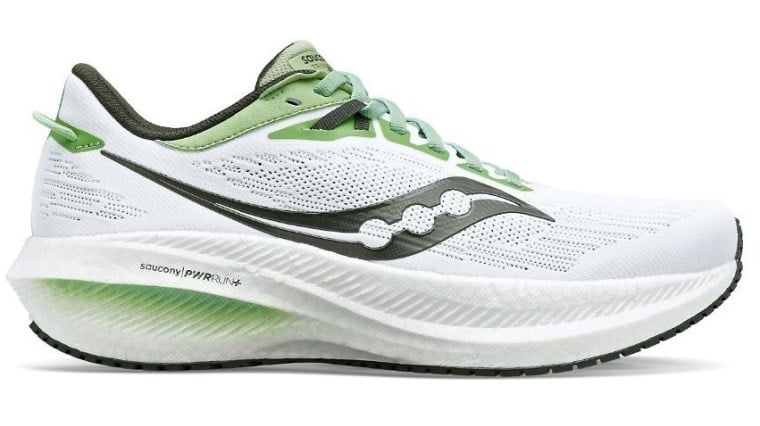
Jumping to the midsole part of today's review. From the Saucony Triumph 17 which is where they re-executed the successful TPU midsole compound, to the Saucony Triumph 21, we've seen subtle improvements in iterations from one season to the next.
The big jump for Saucony was going from the Saucony Triumph 19 to the Saucony Triumph 20 where they increased the heel-to-toe offset by 2mm. Saucony running shoes were known for years for being on an 8mm drop and less. Going to that 10mm heel-to-toe offset with the Saucony Triumph 20, we thought in early days that it was going to maybe work against this running shoe.
However, the Saucony Triumph 20 was such a successful shoe last year in 2022 and the front half of 2023, and we are going to expect the same outcome here with the Saucony Triumph 21.
The midsole compound itself is a TPU base. It's a PWRRUN+ foam which is what Saucony have badged this technology as. The biggest change with the Saucony Triumph 21 from the Saucony Triumph 20 is we have gone up 2mm in overall stack height.
Last year we had 35mm in the heel and 25mm in the forefoot. This year we have 37mm in the heel and 27mm in the forefoot. A 2mm increase doesn't sound like a whole lot, but it is regarding the overall execution of a midsole. Seeing as it’s the same technology, it should run the same with a little bit more longevity because you're a bit higher off the ground.
The only thing that may be of concern is that by going a little bit higher, we might have to push through the midsole a little bit more to get that engagement. However, I'm not too concerned because TPU-based midsoles, and with 2mm of variance, are going to compress quite quickly with entry on your strike pattern, be it heel, midfoot, or forefoot striking.
I'm not overly concerned, but there is always an element of doubt where brands make subtle iterations from stack height regarding increasing or decreasing it, but continue to use the same materials from one season to the next.
However, in terms of the overall comfort of this running shoe, I want to talk about one of the best features which is probably the cheapest part of manufacturing the shoe - the sockliner.
The PWRRUN+ sockliner is exactly what you want - giving you the same technology in the innersole/sockliner as in the midsole.
I say this with all due respect to running shoe brands, but a lot of them put time and effort into the outsole, midsole and upper and then put in a relatively cheap sockliner. That can quite easily undo a lot of the great work that brand has spent on executing a high performing shoe.
Having a really comfortable sockliner not only makes the step-in experience much more plush, but it also makes the overall experience of running in the shoe significantly better by providing a slightly softer footbed underneath your foot. It then allows the midsole to do everything it needs to do in regards to cushioning, stability and response through toe-off.
Weight
The other thing I'd like to touch on is that we have gone up 2mm in stack height for 37mm in the heel and 27mm in the forefoot, however the running shoe weight is the same.
When brands increase the amount of cushioning underneath the foot, you would expect the weight of the running shoe to go up. However, it's virtually the same weight in the Saucony Triumph 21 as it is in the Saucony Triumph 20 from last season.
The reason they've kept the weight down is because this upper construction is very light. That flat-knit construction is strong and breathable, but with lighter materials which allows the weight to stay the same.
The Wrap Up
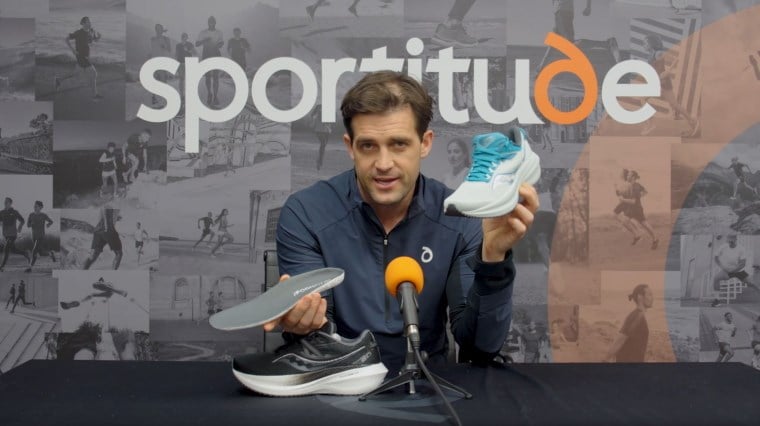
There you have it, that's my take on the Saucony Triumph 21 and where it’s come from regarding the Saucony Triumph 20.
I really loved the Saucony Triumph 20. It was a fantastic running shoe and it performed really well for me. I loved getting out the door and taking my long runs in that shoe.
I've done a few runs in the Saucony Triumph 21 and the outcome is exactly the same. It's a great running shoe with subtle changes with the stack height, midsole and the upper.
However, as I touched on, going up half a size was a great move for me but it may not be the case for everyone else who tries this running shoe on.
I encourage you to go to your speciality running shoe store, have a conversation with a team member if you're coming from the Saucony Triumph 20 and you want to go to the Saucony Triumph 21. You want to make sure you lace it up and get that size absolutely dialled in.
I like to give my subjective opinions on running shoes and that's what I've been doing for a number of years. However, the great validation for me is our team members downstairs that literally have the pick of the shop. It's like a candy store for them to grab whatever shoe they like and test it out from time to time.
I can tell you honestly hand on heart that around 60% of our team members downstairs at Sportitude Running have either the Saucony Triumph 20 or Saucony Triumph 21 in their shoe rotation right now, or they have had it in their rotation over the last 12 months.
It's a high performing shoe, it's incredibly comfortable, very balanced, snappy and responsive for a mileage shoe.
It is going to do exactly what it is pitched to do. It's going to be stable, cushioned and offer plenty of comfort out on the road for all those miles that you the running community will be doing.
If you have any questions comments or theories about the Saucony Triumph 21, please contact our running shoe experts. Please subscribe to the Sportitude YouTube channel to stay notified and we'll keep pumping out these shoe reviews for you the running community all over the world.
Thank you very much for tuning in, we appreciate your time. Until next time stay safe, be kind to one another, happy running and we'll see you on the road. Take care.
FEATURES
- Support: Neutral
- Upper: Mesh
- Midsole: Saucony PWRRUN+
- Heel Height: 37mm
- Forefoot Height: 27mm
- Offset / Drop: 10mm
Men
- Weight: 279g / 9.8oz
- Width: D (standard), 2E (wide)
Women
- Weight: 250g / 8.8oz
- Width: B (standard), D (wide)
Saucony Triumph 20
For a more in-depth shoe fitting experience, you can book a free 15 minute video chat in a Live Fit session or make an appointment to discover your RunDNA at Sportitude Running@Hindmarsh.
Book your RunDNA assessment today!
Happy running!

